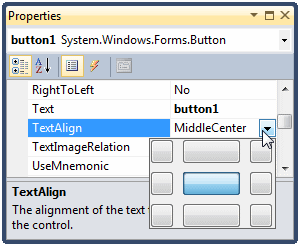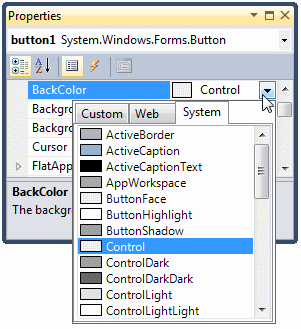 |
Microsoft Visual Studio Tools: The Properties Window |
|
|
|
A property is a piece of information that characterizes
or describes a control. It could be related to its location or size. It
could be its color, its identification, or any visual aspect that gives it
meaning. The properties of an object can be changed either at design time or
at run time. You can also manipulate these characteristics both at design
and at run times. This means that you can set some properties at design time
and some others at run time.
|
|
To manipulate the properties of a control at design
time, first select it on the form. While a control is selected, use the
Properties window to manipulate the properties of the control at design
time. To access the Properties window if it is not visible:
- On the main menu, you can click View -> Properties Window
- On the form, you can right-click anything (either the form itself or
any control positioned on it) and click Properties
- The shortcut to display the Properties window is F4
|
|
The Properties window uses the behaviors we reviewed in
Lesson 1 about auto-hiding, docking, floating or tabbing the tools that
accompany Microsoft Visual Studio 2010. This means that you can position it
on one side of the screen or to have it float on the screen as you wish.
The Properties window is divided in 5 sections:
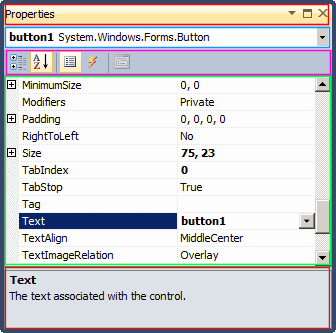
The Properties window starts on top with a title bar,
which displays the string Properties. If the window is docked somewhere, it
displays the Window Position
 ,
the Auto-Hide ,
the Auto-Hide
 ,
and the Close ,
and the Close
 buttons on its right side. If the window is floating, it would display only
the Close button.
buttons on its right side. If the window is floating, it would display only
the Close button.
Under the title bar, the Properties window displays a
combo box. The content of the combo box is the name of the form plus the
names of the controls currently on the form. Besides the technique we
reviewed earlier to select a control, you can click the arrow of the combo
box and select a control from the list:
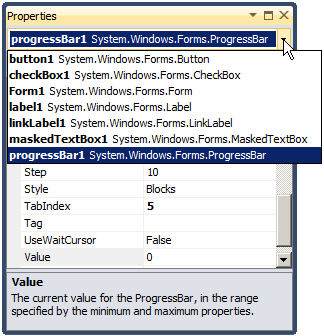
Under the combo box, the Properties window displays a
toolbar with 4 buttons.
Under the toolbar, the Properties window displays the
list of properties of the selected control(s). On the right side, the list
is equipped with a vertical scroll bar. The items in the Properties window
display in a list set when installing Microsoft Visual Studio. In the
beginning, you may be regularly lost when looking for a particular property
because the list is not arranged in a strict order of rules. You can
rearrange the list. For example, you can cause the items to display in
alphabetic order. To do this, on the toolbar of the Properties window, click
the Alphabetic button
 .
To restore the list, you can click the categorized button .
To restore the list, you can click the categorized button
 . .
Two lists share the main area of the Properties window.
When the list of properties is displaying, the Properties button is clicked
 .
The second is the list of events. Therefore, to show the events, you can
click the Events button .
The second is the list of events. Therefore, to show the events, you can
click the Events button
 .
If the events section is displaying, to show the list of properties, you can
click the Properties button .
If the events section is displaying, to show the list of properties, you can
click the Properties button
 . .
Under the list of properties, there is a long bar that
displays some messages. The area is actually a help section that displays a
short description of the property that is selected in the main area of the
Properties window.
|
Accessing the Properties of One or More Controls
|
|
Based on a previous description,
- If the Properties window is already displaying, to access the
properties of the form or of a control, simply click it
- If the Properties window is not displaying, to access the
characteristics of an object, right-click either the form or a control
on the form and click Properties
- If the Properties window is not available, to access the
characteristics, click either the form or a control on the form and, on
the main menu, click View -> Properties
When a control is selected, the Properties window
displays only its characteristics:
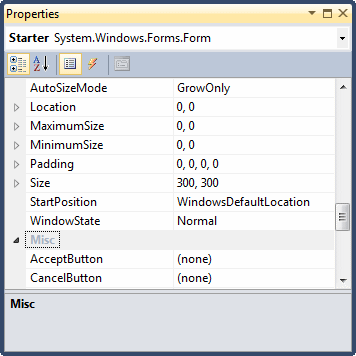
You can also change some characteristics of various
controls at the same time. To do this, first select the controls on the form
and access the Properties window:
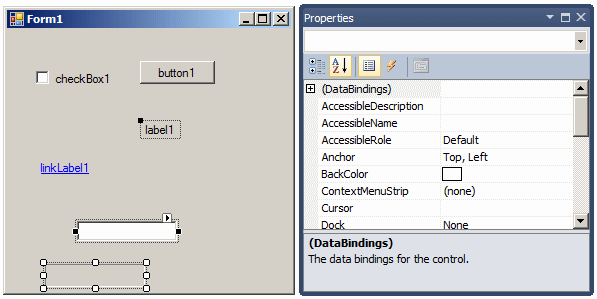
When various controls have been selected:
- The Properties window displays only the characteristics that are
common to the selected controls
- The combo box on top of the Properties window is empty
- Some fields of the Properties window appear empty because the
various controls that are selected have different values for those
properties
|
 Application:
Introducing the Properties Window Application:
Introducing the Properties Window
|
|
- To create a new application, on the main menu, click File -> New
Project...
- In the middle list, click Windows Forms Application
- Set the Name to Exercise4 and click OK
Each field in the Properties window has two sections:
the property’s name and the property's value:
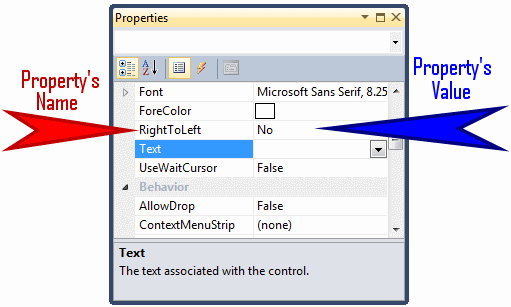
The name of a property is represented on the left
column. This is the official name of the property. The names of properties
are in one word. You can use this same name to access the property in code.
The box on the right side of each property name
represents the value of the property that you can set for an object. There
are various kinds of fields you will use to set the properties. To know what
particular kind a field is, you can click its name. To set or change a
property, you use the box on the right side of the property’s name: the
property's value, also referred to as the field's value.
|
 Application:
Displaying the Properties Window Application:
Displaying the Properties Window
|
|
- To display the Properties windows, on the main menu, click View ->
Properties Window
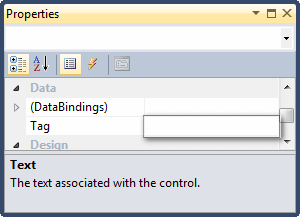 |
By default, these fields have nothing in their
value section. Most of these properties are dependent on other
settings of your program. For example, you can set a menu property
for a form only after you have created a menu.
To set the property on such a field, you can
type in it or select from a list.
|
|
 Application:
Checking Empty Fields Application:
Checking Empty Fields
|
|
- Click the body of the form.
In the Properties windows, notice
that the AccessibleName and the Tag fields are empty
There are fields that expect you to type a value. Most
of these fields have a default value. Here is an example:
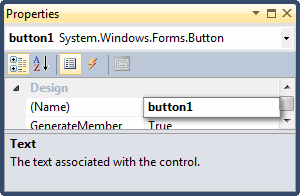
To change the value of the property, click the name of
the property, type the desired value, and press Enter.
While some properties, such as the Text, would
allow anything, some other fields expect a specific type of text, such as a
numeric value.
|
 Application:
Checking Text Fields Application:
Checking Text Fields
|
|
- In the Properties windows, click Text and notice that it contains a
string in bold characters
- Click (Name) and notice that it contains some bold characters
Some fields expect a numeric value. In this case, you
can click the name of the field and type the desired value. Here is an
example:
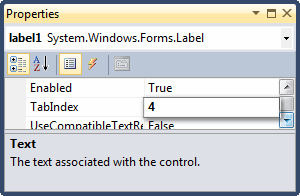
. If you type an invalid value, you would receive a
message box notifying you of the error:
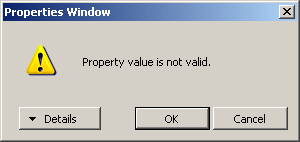
When this happens, click OK and type a valid value. If
the value is supposed to be an integer, make sure you don't type it as a
decimal number.
|
 Application:
Checking Numeric Fields Application:
Checking Numeric Fields
|
|
- In the Common Controls section of the Toolbox, click NumericUpDown
 and click the form (no need for precision)
and click the form (no need for precision)
- While the control is still selected on the form, in the Properties
windows, click Value and notice that it contains a number string in bold
characters
- Click the DecimalPlaces, the Increment, the Maximum, and the Minimum
fields to see that they contain numeric values:

Some fields expect you to enter a date. You must type a
valid date recognized by the operating system and the Regional and Language
Settings in Control Panel. If you enter an invalid date, you would receive
an error.
|
 Application:
Checking Date and Time Fields Application:
Checking Date and Time Fields
|
|
- In the Common Controls section of the Toolbox, click DateTimePicker
and click the form (no need for precision)
- While the control is still selected on the form, in the Properties
windows, click Value and notice that it contains a date and time value
- Click the MinDate and the MaxDate fields to see their values:
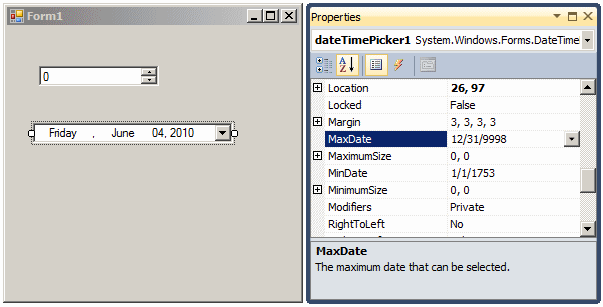
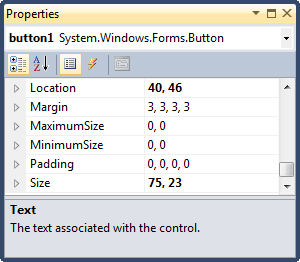 |
Some fields have a right-point button. This
indicates that the property has a set of sub-properties that
actually belong to the same property and are defined together. To
expand such a field:
- Click its right-point button
- Double-click the property name
After expanding the field, it would be equipped
with a down-right pointing arrow:
|
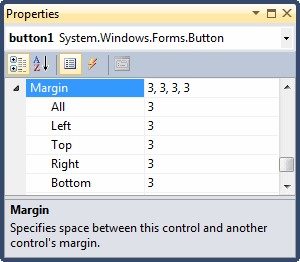 |
To collapse the field, click the - button.
Some of the properties are numeric based, such as the
Location or the Size. With such a property, you can click its
name and type two numeric values separated by a comma. Some other properties
are created from an enumeration or a class. If you expand such a field, it
would display various options. Here is an example from the Font
property:
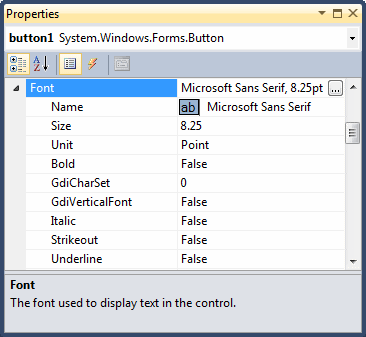
With such a property, you should select from a list.
|
 Application:
Checking Expandable Fields Application:
Checking Expandable Fields
|
|
- Click an empty area of the form to select the form
- In the Properties window, double-click the Font name to expand it
and notice that it display some previously hidden items
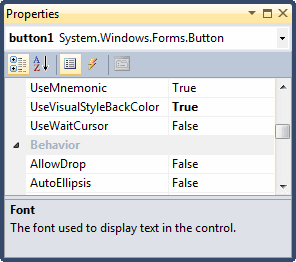 |
Some fields can have only a True or
False value. To change their setting, you can either select from
the combo box or double-click the property to toggle to the other
value.
|
|
 Application:
Checking Boolean Fields Application:
Checking Boolean Fields
|
|
- In the Properties window click Enabled and notice that it displays
True
- Under Font, click Bold and notice that it displays False
|
Some fields would require a value or item that
needs to be set through an intermediary action. Such fields display
an ellipsis button
 .
When you click the button, a dialog box would come up and you can
set the value for the field. .
When you click the button, a dialog box would come up and you can
set the value for the field.
|
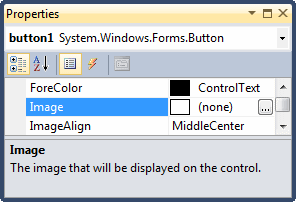 |
|
 Application:
Checking Action Fields Application:
Checking Action Fields
|
|
- In the Common Controls section of the Toolbox, click PictureBox and
click the form (no need for precision)
- While the control is still selected on the form, in the Properties
windows, click Image and notice that the field displays an ellipsis
button


- Click the ellipsis button and notice that a dialog box comes up
- Click Cancel
To change the value of some of the fields, you would use
their combo box to display the available values. After clicking the arrow, a
list would display:

There are various types of list-based fields. Some of
them display just two items. To change their value, you can just
double-click the field. Some other fields have more than two values in the
field. To change them, you can click their arrow and select from the list.
You can also double-click a few times until the desired value is selected.
|
 Application:
Checking List-based Fields Application:
Checking List-based Fields
|
|
- Click an empty area of the form to select the form
- In the Properties window, click FormBorderStyle and notice that it
displays an arrow button of a combo box
- Press Alt and the down arrow key to display the list
- Press Esc
Some properties provide a window from where you can
select the desired option. The field primarily displays the arrow of a combo
box. To use the field, you click the arrow of the combo box and the window
appears. Here are examples:
After expanding the window, you can select the desired
option. We will eventually review them.
|
 Application:
Checking Area-Selection Fields Application:
Checking Area-Selection Fields
|
|
- On the form, click one of the controls
- In the Properties window, click Dock and click the arrow of its
combo box
- Notice the window that comes up and press Esc
- On the main menu, click File -> Close Solution or File -> Close
Project
- When asked whether you want to save, click Discard
|
|



















